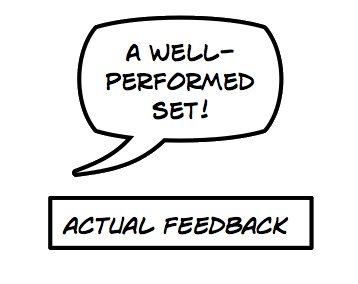Published Tick-the-Code Material
Happy Are The Software Engineers.. (article)
My first ever published article is called "Happy Are The Software Engineers.." and it appeared in Better Software magazine in December 2006. The article describes briefly how complete concentration can create the feeling of happiness especially if the task at hand is meaningful. I wanted to highlight that working for software quality is meaningful and with Tick-the-Code you can achieve complete concentration.
Simply put, happiness is Tick-the-Code.
Tick-the-Code Inspection: Theory and Practice (paper)
My first ever scientific paper is called "Tick-the-Code Inspection: Theory and Practice" and it appeared in the peer-reviewed publication of ASQ (American Society for Quality) called Software Quality Professional.
As the name says, the paper reveals all details of Tick-the-Code up to the 24 coding rules. At the moment this paper is the most comprehensive written source for information about Tick-the-Code.
Tick-the-Code Inspection: Empirical Evidence (on Effectiveness) (paper)
My second paper is called Tick-the-Code Inspection: Empirical Evidence (on Effectiveness). It was prepared for, and first presented at, Pacific Northwest Software Quality Conference 2007. The paper presents measurements taken in Tick-the-Code training courses so far (about 50 sessions with over 300 software professionals). The results are revealing. The main point of the paper is that software engineers could keep their software much simpler and avoid making many of the errors software projects are so notorious for.
In the Appendix of the paper, you'll find all the active rules of Tick-the-Code at the time of writing (summer 2007).
Tick-the-Code - traditionally novel technique in the fight against bugs (article)
Pirkanmaan Tietojenkäsittely-yhdistys (Pitky ry) published my article in their member magazine Pitkyn Piiri 1/2008. It is called "Tick-the-Code - uusvanha tekniikka taistelussa bugeja vastaan" and it is only available in Finnish.
An Example Rule Introduced
There are 24 active rules in Tick-the-Code. Each one of them helps to locate either omissions, redundancies, ambiguities, inconsistencies or assumptions in the source code. Individual rule violations might seem minor, but when you let them accumulate long enough, you'll be in trouble.
Marked rule violations are called ticks. Try the following rule on your production-level code and see how many ticks you can find. Then analyze each tick and see if you can't improve the maintainability of your code.
The rule sample changes weekly, so in a mere 24 weeks of diligent visits, you can have yourself the complete set of Tick-the-Code rules. However, there is an easier way and you'll be rewarded with laminated rule cards to top it all up. Get trained! Contact Qualiteers if you want to know more.
CHECK-IN
"Each routine shall check its input data."
Input data are parameters, member data and global variables (*shudder*) used in a routine. Each routine must make sure before using any of the values that they are usable. Sometimes a value must be within a range, sometimes a pointer address can be approximately known and when a value doesn't check out, any further processing is stopped. This is called defensive programming. The assert macro is an excellent tool for this purpose.
By the way, anything you can do with global data, you can do better with access routines.
Future Work
Tick-the-Code Inspection: The Book (book, working title)
Since 2006, there's a book on Tick-the-Code on the works. Currently the book project is on ice, as I study and gather more material and field experiences to include in the book. The book will be the most comprehensive written source on Tick-the-Code.
Excerpt from the book
The excerpt changes weekly. Each excerpt is still a draft version and might change before ending in the book.
The overly complex can become a real adversary, against which the lone software developer has no weapons. Tick-the-Code gives you the right kind of weapons (the technique) and enough ammunition (the rules) to start taking care of business. Releasing an empowered ticker on source code will turn the tables for good. The code then becomes the servant and the developer starts calling the shots as the master. With Tick-the-Code you can disarm the misbehaving source code and restore the right balance.
Tick-the-Code is a low-tech approach to code review. It is brain-intensive, focus-inducing and counterintuitive. We could even say that it is taking you back-to-basics, to the grass-root level of the source code. Tick-the-Code is heavy as paper and result-driven. It is at times purely mechanical and sometimes heuristic, all the time puzzling and at best creativity-inspiring. Ticking code free from the shackles of technology can be therapeutic and at the same time both arming and disarming. It is all these things and more.
It can be helpful to describe what Tick-the-Code is not. It isn't reactive. You can't automate it and it isn't just for beginners.
















